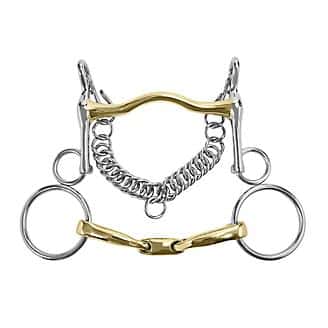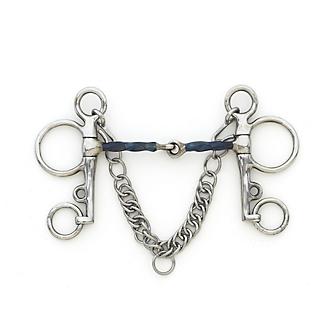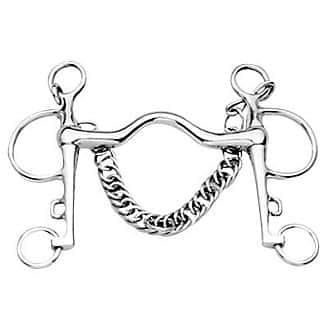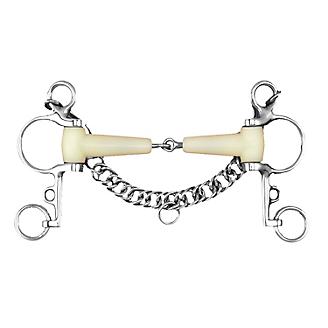Finding the right bit for your horse’s mouth can be a bit of a challenge. When your horse has become too strong in hand, you may feel like you need a stronger bit such as a pelham bit.
If you rode as a kid, this type of bit was what most like what your horse was fitted with. The pelham bit, with its curb chain attachment, is a strong bit that reduces the need for pressure or force, making it an easier bit for a child to control a restless horse.
In this article, I’m going to tell you just about everything you want to know about a Pelham bit so you can decide if it’s a good fit for you, your horse, and/or your child.
P.S. To learn more about different kinds of bits, you might want to check out this article. And this one will help you decide what kind of bit is best for you and your horse!
This article contains affiliate links, which means we may earn a commission if you choose to make a purchase (at no extra cost to you).
What Is a Pelham Bit?
A pelham bit is a bit type that has a shank at each end. The mouthpiece can be a solid or jointed mouthpiece, but when it’s solid, it has a raised center area called a port. It usually looks something like this:

As you can see, a curb chain is suspended between the two sides of the bit. This chain is placed flat along the horse’s jawbone, providing stability and preventing the horse from raising their head excessively when applying pressure to the reins.
Uses of Pelham Bits
Pelham bits are used in English riding to help provide elevation by shortening the horse’s stride. When used with a double bridle with a jointed snaffle bit, the rider can control the horse’s bend and the height of their movement or elevation. With a double set of reins, the rider’s hands can signal each part of the horse’s mouth, encouraging more forward movement or shortening their movement to show prancing.
In Western riding, cross country riding, hunter classes, and regular hacking, a pelham bit provides better brakes to the horse. With the greater leverage of the pelham bit, the rider can exert more pressure on the horse’s mouth to achieve a quick stop or prevent the horse from running away (at times).
How the Pelham Bit Works
To engage the Pelham bit, simply apply some gentle downward pressure on the reins, which will raise the mouthpiece against the bars of the mouth. When the rider pulls back on the reins, the shanks will engage, leveraging the curb to lie flat against the horse’s chin. This causes pressure at the poll, jaw, and chin which encourages the horse to lower their head and slow their pace.
The jointed mouthpiece of the pelham bit allows for more bend. With pelham converters or joiners, the pelham bit can be used with a single set of reins. The pelham bit should never be yanked with force as it has sufficient leverage to severely injure a horse’s mouth.
When combined with rubber reins or other special reins such as a market harborough, the pelham or curbed bit provides more control (though it can potentially cause your horse to start pulling against the bit and resist riding if you use it harshly).
Riders with soft hands do well with pelham bits, while a rider who has hard hands will be more likely to damage the horse’s mouth over time if they keep riding using pelham horse bits. When used with two sets of reins, the curbed bit or pelham bit can be modulated in its severity. However, if you ride with only one rein, you may apply too much pressure, overbending the horse’s neck and forcing the horse’s head down unnaturally.

How to Correctly Fit a Pelham Bit
The Western and English pelham bits should be fitted to only leave a very soft wrinkle at the corner of the horse’s mouth when not engaged. To avoid pinching, ensure the bit is wide enough to allow a pinky finger to be inserted on either side of the horse’s mouth when the bit is resting on their tongue.
The metal curb fits into the groove that a horse naturally has between their chin and their jawbone. When adjusted correctly, the curb should hang loose when the horse moves forward. Then when the reins are engaged, the curb should raise into the chin groove, pressuring the jawbone.
The curb, when engaged, applies pressure to stop the horse from running forward.
Curb bits (like a Kimberwick bit) and some English pelham bits (like a tom thumb) have two bit rings at each end—a snaffle ring and a curb ring. The rider can select which bit rings the reins should be attached to for a “snaffle setting” and a “curb setting.” When riding with two sets of reins, the rider can decide whether they will engage the curb or shank bit or the snaffle bit.
Pros and Cons of the Pelham Bit
A pelham bit is not for everyone, nor is it for all horses. Some horses prefer a simple snaffle bit, while other horses prefer to go completely bitless or work off a neck rein. There are pros and cons to riding in a pelham bit.
Pros of Riding in a Pelham Bit
Riding in a pelham can help a rider who has restless hands to settle while interfering as little as possible with the horse’s mouth. Nervous riders also prefer the sense of having ABS brakes with the curb action.
- Control of the Horse’s Head
Pelham bits with a high port may offer better control of the horse’s head; however, the manner in which you introduce the bit will determine whether your ride is successful or not. A bit should never be a device of pain or punishment.
- Instruction of the Horse
A pelham bit can be used with a double bridle and snaffle bit at the higher levels of riding to balance bend with collection. The rider would typically ride with two sets of reins, with a snaffle rein being the primary rein and the curb reins being there to support the horse’s energy.
- Creates Lightness in a Competition Horse
In Western riding, a horse can be trained in a pelham bit to develop their balance and lowered head carriage. The curb bit lowers the horse’s head and longer shanks will exert a stronger pressure on the bars of the mouth. Shorter shanks will provide less pressure, making it better suited to riding in snaffle reins. The longer shanks allow the rider to apply fingertip pressure to the reins.
- Develops Lightness in the Rider’s Hands
When you know you’re riding with a strong and potentially dangerous bit, you will be more conscious of pulling or drawing the reins in harshly. While a bit converter can help in reducing pressure on the curb chain, your hands need to learn to be soft, riding on the fingertips alone.
Cons of Riding in a Pelham Bit
Those interested in natural horsemanship are heavily opposed to pelham bits as these bits can potentially damage the horse’s mouth. Whether you are riding in a kimblewick, a tom thumb, or any other pelham bit, there are certain risks that you should be aware of.
- Excessive Pressure
As mentioned, the longer shanks of a pelham or tom thumb bit can increase the amount of pressure applied to the sensitive bars of the horse’s mouth. With more leverage, the horse can begin to react negatively. You may end up with other riding problems such as head tossing, overbending, and bucking as the horse tries to get away from the pressure.
- A Fixed Curb Bit Reduces Bend
When your horse is being ridden in a fixed pelham bit, which has no joint in the middle, the left and right sides of the bit can’t work independently, which will reduce the ability of the horse to be cued to bend to the left or right. You can eliminate this problem with a jointed pelham or a curb set with a snaffle bit included.
Pelham Vs. Kimberwick Bits
There are subtle differences between a kimberwick bit and a pelham bit. For one, the shanks of a kimberwick are much shorter than the average pelham bit.
The mullen ends of the mouthpiece on a kimberwick also reduce the possibility of the bit pinching your horse. There is significantly less pressure and leverage on the bars because of the lack of shanks.
The reins can be set to the snaffle setting or the “curb” setting, and the curb chain barely engages when in use. A kimberwick can be used with double reins, and a lip strap can also help a mouthy horse better settle with the bit. The lip strap fits better with a kimberwick due to the absence of shanks.
For more information on the different types of pelham bits, let’s look at some great examples.
Different Types of Pelham Bits
There are many different types of pelham bits. Most fit the typical shanked bit with a curb chain prototype, but there is some variation between the mouthpieces and shank length. Each type offers its own unique benefits, making it more or less suited to your horse’s mouth.
Best Curb Set

The Sanft Short Shank Curb and Bradoon Set is ideal for the dressage rider moving up to a double bridle curb set. The combination of a fixed pelham bit with an elliptical snaffle is a great bit set for bend, collection, and control.
Pros
- Specific action on either side of the horse to allow flexion
- Effective communication with the horse to use the horse’s energy for elevated movements such as the piaffe
Cons
- Can be harsh in the horse’s mouth if incorrectly fitted
- Requires higher levels of training for the rider to use effectively
Best Tom Thumb Bit

The Blue Steel Slow Twist Tom Thumb Pelham Bit is a control bit for more pressure and hold on a horse that is a bit strong in hand. The blue steel mouthpieces have faster oxidation rates, which will produce sweet tastes and improve salivation to lubricate the horse’s mouth.
Pros
- Precise action on the bars of the mouth
- Sweet taste for better salivation and acceptance of the bit
Cons
- Nutcracker action can be very harsh on the horse’s mouth
- Hinged sides can pinch the sides of the horse’s lips
Best Plain Curbed Pelham Bit

If you ride in high excitement situations such as equine sports like polo and barrel racing, you may prefer a bit like the Korsteel Polo Pelham Bit, which has a high port for extra control and better leverage in the mouth.
Pros
- When ridden with two reins, a measure of bend can be achieved, though the primary goal is to stop forward motion for quick turns
- High leverage with the six-inch shanks
Cons
- Can be hard on the mouth and lead to the horse leaning on the bit
- The heavy-duty curb chain can cause rubbing of the horse’s jawbone in the curb groove (but changing out for a curb strap that is leather or has a sheepskin padding can prevent this damage)
Best Soft Mouth Pelham Bit

If you want the pelham action but would rather not have a hard bit in your horse’s mouth, you can opt for a happy mouth pelham like this Happy Mouth Jointed Pelham Bit, which is available with a French link or elliptical mouthpiece.
Pros
- The mouthpiece is soft with the patented “Happy Mouth” flavored coating to soften impact on the bars of the mouth
- Flexibility to give more yield to the bit
- Excellent control and bend with the jointed mouthpiece
Cons
- Not all horses like the “Happy Mouth” flavor
- The coating can begin to wear through with prolonged use
A Final Word on Pelham Bits
Your choice of pelham bit will depend greatly on what you prefer to ride in, what your horse responds to, and what kind of riding you do. Never force a horse to accept a bit. Just like people, horses prefer their own unique bit, so you might want/need to try different bits to find the one that works for your horse.
If you want to learn about different bits, you can read our guide on different types of horse bits.

